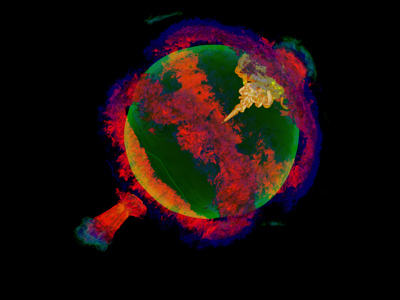|
||
      |
Next Generation
A star is burned
In January Chicago astrophysicists traveled to northern California to blow up a star the size of the earth. The detonation was simulated—the first such demonstration performed in 3D and not triggered manually by scientists at the keyboards—and the star was a dying white dwarf.
 Tightly packed with 1.5 times the sun’s mass, white dwarfs explode the way fuel ignites inside a diesel engine: the stars compress until, at about 2,000 tonnes per cubic centimeter, internal nuclear combustion erupts to the surface. The ensuing explosion produces a 1a supernova, which astrophysicists believe may help predict the universe’s accelerating expansion, caused by dark energy.
Tightly packed with 1.5 times the sun’s mass, white dwarfs explode the way fuel ignites inside a diesel engine: the stars compress until, at about 2,000 tonnes per cubic centimeter, internal nuclear combustion erupts to the surface. The ensuing explosion produces a 1a supernova, which astrophysicists believe may help predict the universe’s accelerating expansion, caused by dark energy.
“To make extremely precise statements about the nature of dark energy and cosmological expansion,” says Chicago’s Robert Fisher, who took part in the simulation, “you have to understand the nature” of minute variations that occur from one supernova to the next. Simulation team leader Don Lamb, director of the University’s Center for Astrophysical Thermonuclear Flashes, says understanding dark energy “will only be possible if we can gain a much better understanding of the way in which these stars explode.”
Unveiled at a Kavli Institute conference March 22, the simulation shows a yellow “flame bubble,” kindled deep within the white dwarf’s core, bursting outward and spiking 1,200 miles to the surface, where it engulfs the star in orange, yellow, and purple rings of burning ash. As those rings collide, as in the image above, they launch one burning jet into space and another into the star, producing temperatures hotter than 5.4 billion degrees Fahrenheit. Then the white dwarf explodes.
In outer space the whole process takes just three seconds, but the Flash Center’s work using two supercomputers at national laboratories in Livermore and Berkeley, California, logged tens of thousands of computing hours. Although other scientists have yet to succeed in replicating Lamb’s findings, telescopic images of the two supernovas closest to Earth seem to match the Flash Center’s simulation.